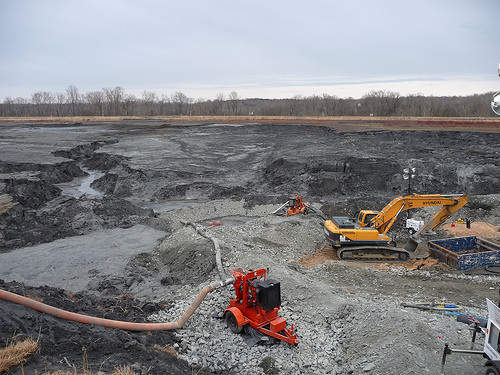Published on Friday, November 22, 2013 by Common Dreams
Energy outlooks predict surge in tar sands, with or without key pipeline
President Obama's approval of the Keystone XL is still uncertain, but that isn't stopping booming production and flow of Canada's tar sands.
Calgary-based Suncor, which touts itself as having "pioneered commercial development of Canada's oil sands," announced on Wednesday that it expects its tar sands production to increase over 14 percent in 2014, reaching up to 430,000 barrels per day in 2014."With no major turnarounds planned in our oil sands business in 2014 and further debottlenecking opportunities, we're set for a strong year of continued production growth," Steve Williams, Suncor president and chief executive officer, said in a media statement.
It's not just Suncor projecting tar sands growth.
In a report issued Thursday, Canada's National Energy Board foresees production of oil in the country surging almost 75 percent between now and 2035, going up to 5.8 million barrels per day, with "situ oil sands production mak[ing] up the majority of the increase."
"Major operating companies have announced expansion plans and foreign entities are investing significant amounts of capital to buy oil sands interests, in many cases forming partnerships with Canadian companies," the outlook states.
All this crude needs to get to refining facilities, but energy companies aren't being held up by a decision on TransCanada's Keystone XL.
Earlier this year, Prime Minister Stephen Harper said, "If we don't do the [Keystone XL] pipeline, more and more [oil] is going to be coming in via rail." This shift is also noted in the NEB report:
The pipeline bottlenecks and price differentials described above have encouraged oil shippers to seek alternative methods to move oil to markets.
Shippers in the U.S. and Canada are increasingly transporting oil by railroad. The flexibility provided by rail transportation allows oil to be delivered from regions lacking pipeline capacity to nearly anywhere in North America with a rail unloading facility.
The trend of crude-by-rail is echoed by the New York Times, which reported on Friday that
over the last several months, oil companies have sought to go around the [Keystone XL] dispute by announcing plans for three large rail loading terminals with the combined capacity of transporting 350,000 barrels a day.
The companies are poised to quadruple rail-loading capacity over the next few years to as many as 900,000 barrels a day, whether or not the Keystone pipeline is built.
But environmentalists have cautioned that crude sidestepping the Keystone XL only to be transported by rail is no better alternative, and have said that the debate is not about a false choice of pipeline or rail but rather stopping the addiction to fossil fuels, as the climate crisis demands.
350.org spokesperson Jamie Henn, for example, has said, "Saying we need to consume tar sands via pipeline because rail lines are dangerous is like saying we need to smoke crack because its better than heroin. Pipelines are also prone to disaster, just look at Exxon's recent spill in the Yellowstone River or the major Enbridge disaster in Kalamazoo."
"The real way to protect our land, water and climate is to break our addiction, not debate delivery mechanisms for the poison," said Henn.
____________________



